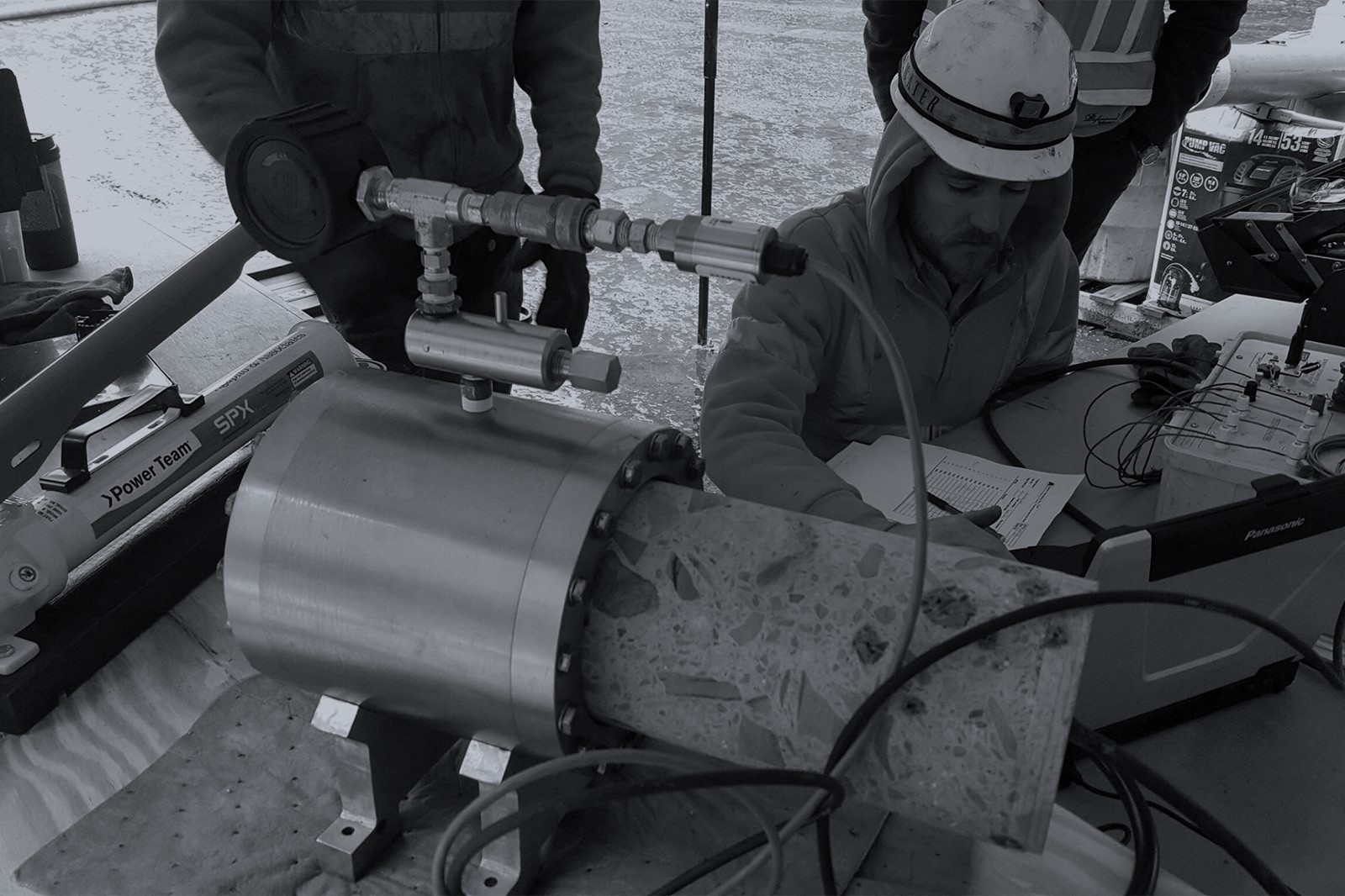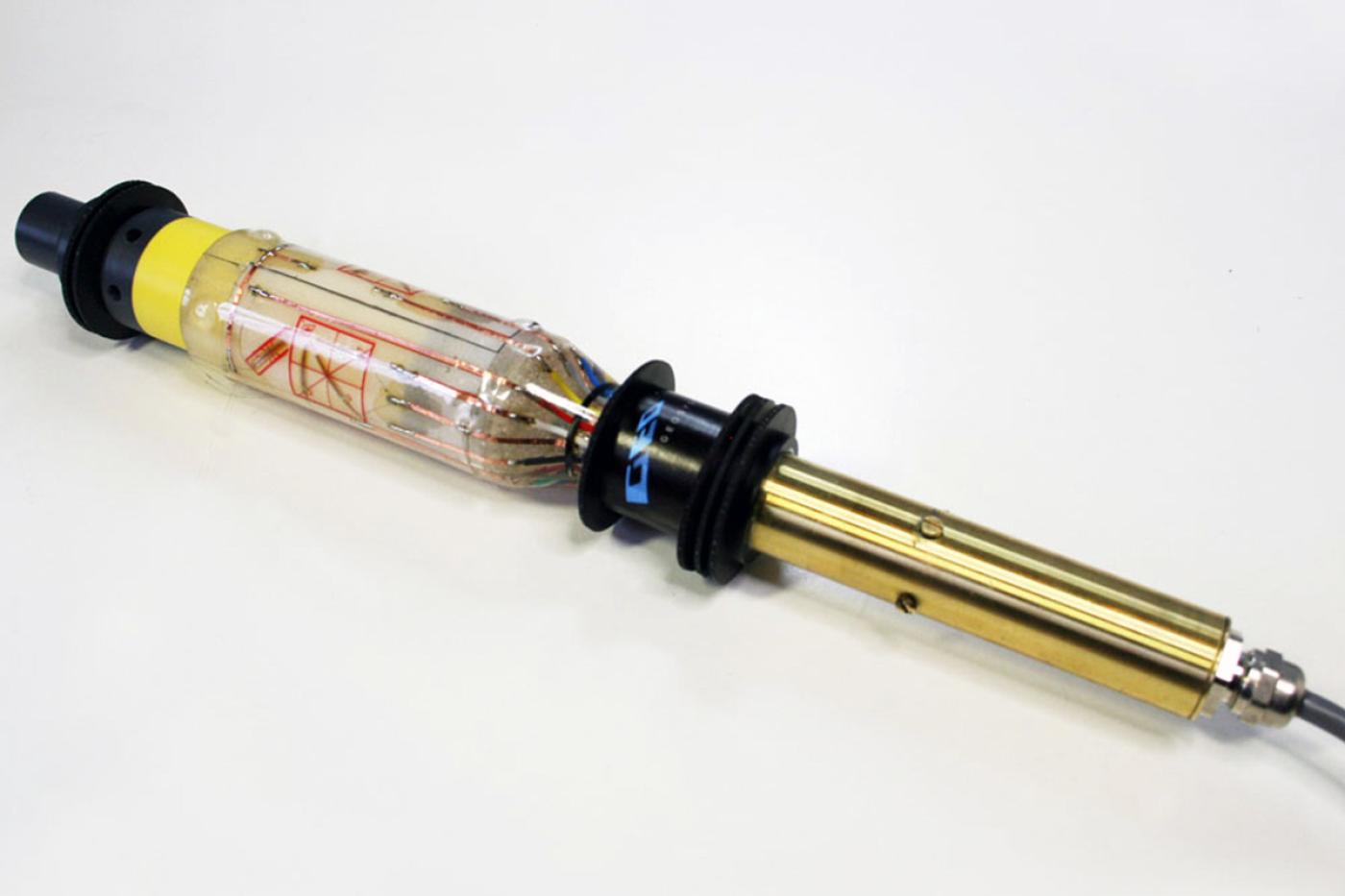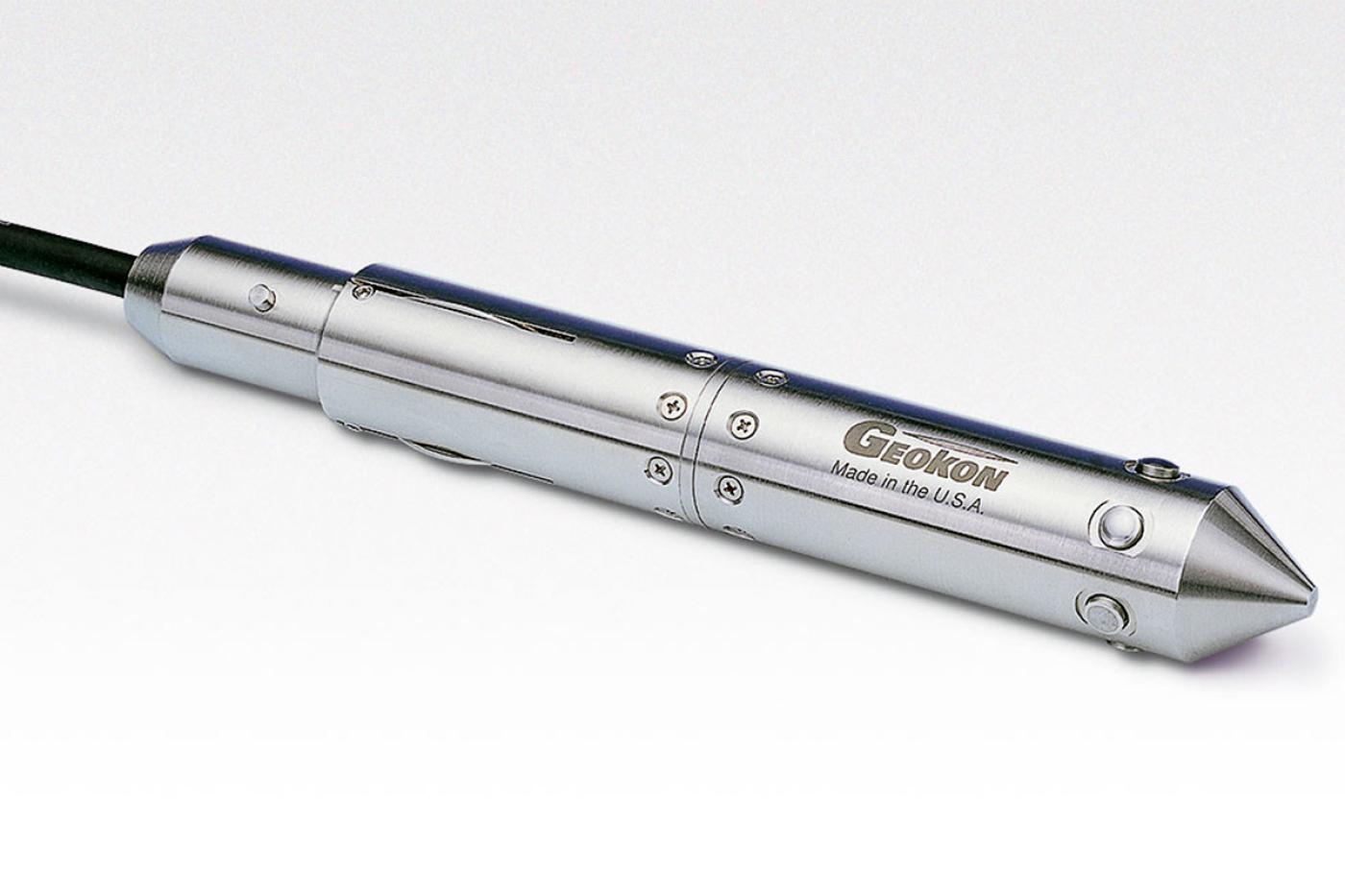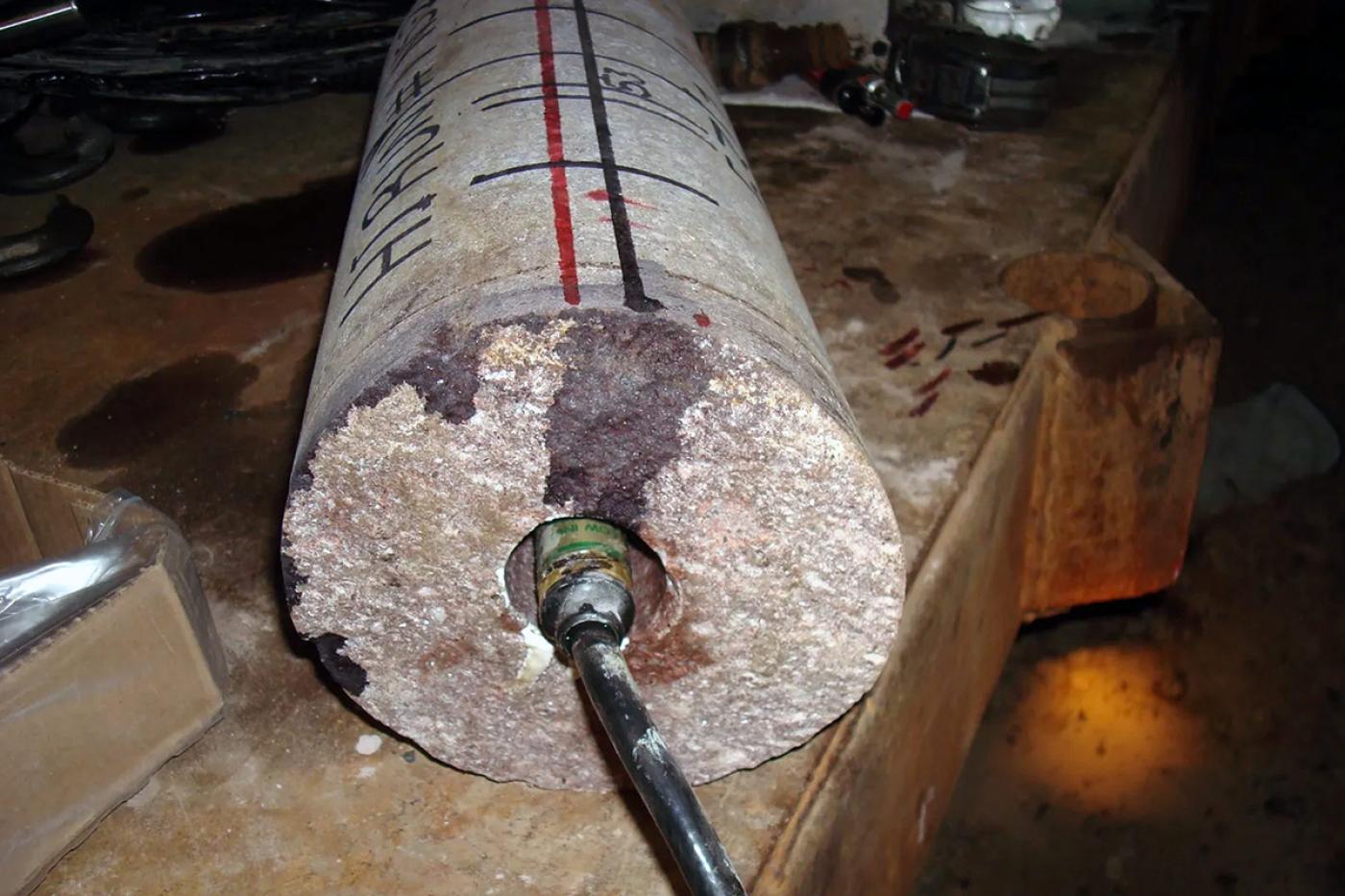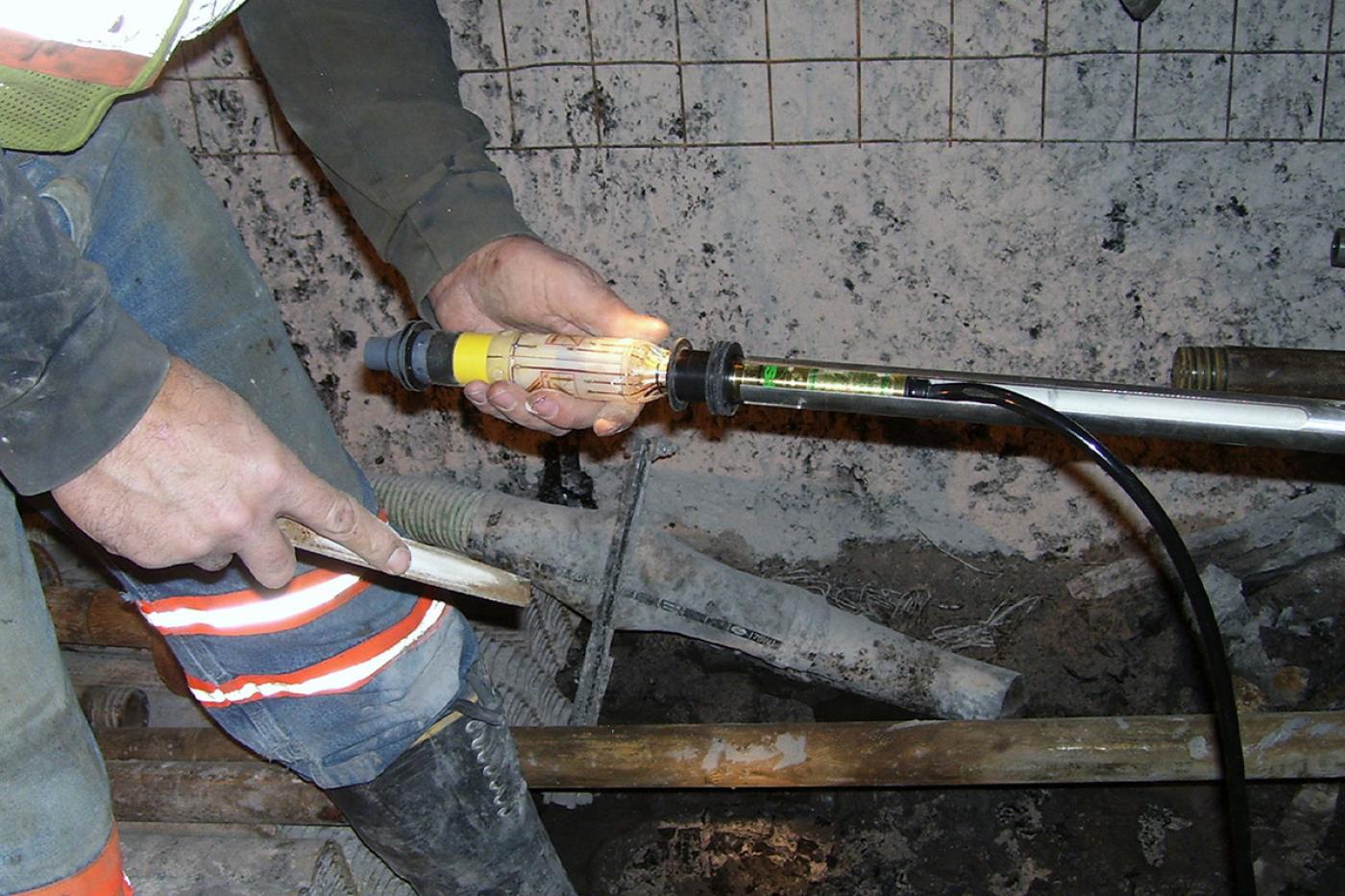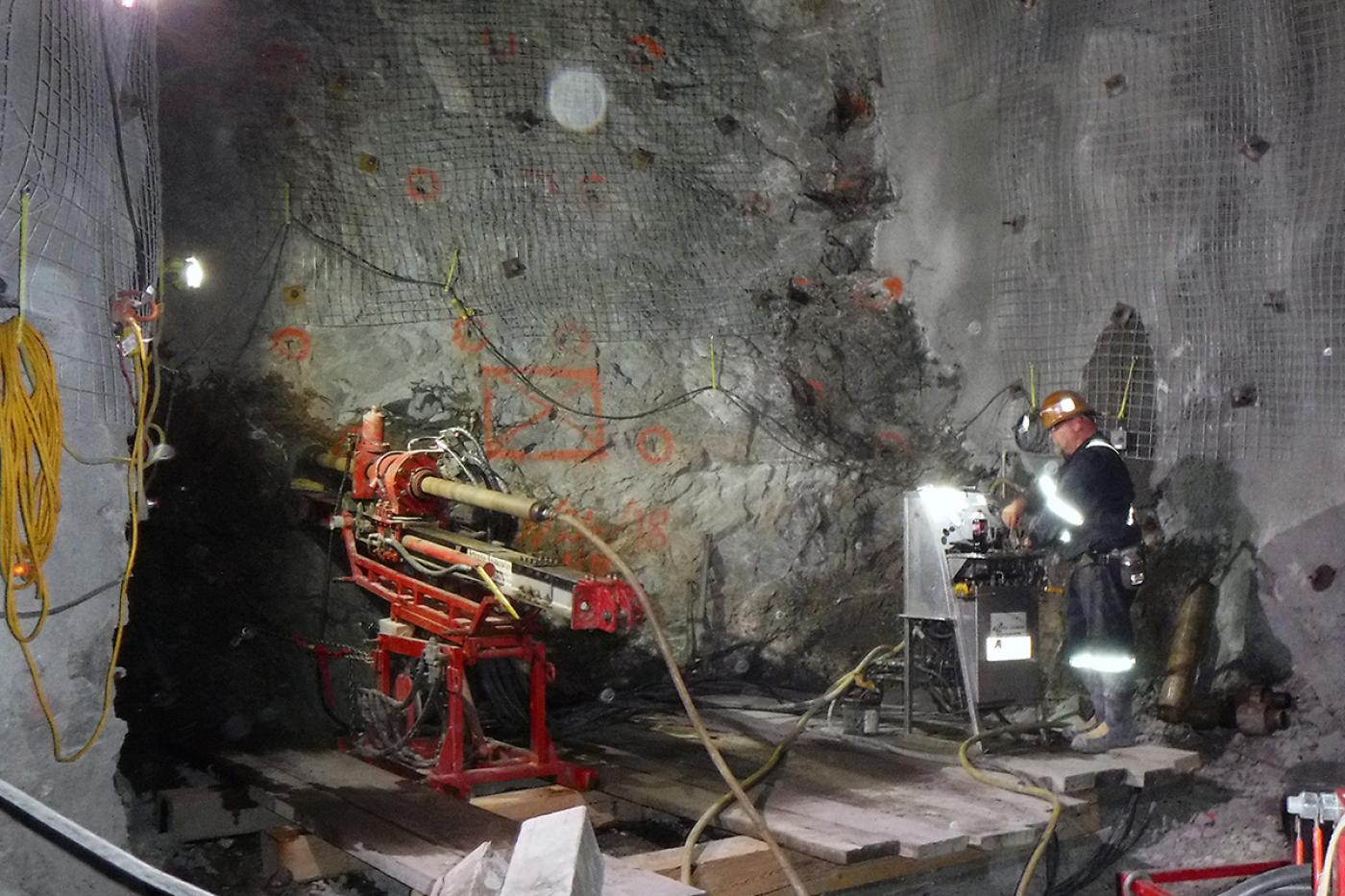DA Smith conducts in situ stress measurements in rock and concrete by both the (1) triaxial (3D) Commonwealth Scientific and Industrial Research Organisation (CSIRO) hollow inclusion cell (CSIRO HI cell) method and (2) the two-dimensional (2D) United States Bureau of Mines borehole deformation gauge (USBM BDG) method. Both methods are used extensively in the civil and mining industries to characterize stress in rock and concrete structures as part of engineering studies.
Both methods measure strain relief in the borehole wall of a pilot hole as the pilot hole is overcored using a larger diameter bit. Strain is resolved to stress according to Hooke’s law and knowledge of the host material’s elastic properties. These methods are commonly referred to as overcoring stress measurements or, simply, overcoring. DA Smith has completed more than 1,500 overcore stress measurements with our core drilling equipment in gold, silver, copper, platinum, molybdenum, trona, oil shale, limestone, and coal mines, as well as tunnels, concrete dams, and other civil structures.
Stresses in rock are sometimes sufficiently high to cause rock bursting, spalling, buckling, heaving, or other ground control problems during mining or excavation. In such cases, knowledge of the stress state is of fundamental importance to the design and development of underground entries. Even in cases where the effects of stress are less dramatic, the optimum shape, orientation, and layout of underground openings, as well as the effectiveness and ultimate cost of rock support systems, can be impacted by the nature of the pre-mining stress state or by stresses induced by construction. Stress measurements can also provide valuable information for evaluating structural behavior in concrete dams, particularly where numerical models are applied to analyze the effects of geologically induced deformation, alkali-silica reaction, and various other time-dependent structural phenomena.
Stress measurements by either the CSIRO HI cell or USBM BDG method can reach depths of approximately 100 feet (30 meters). This depth is controlled by the rods that are used to manually place the cells or BDGs in the pilot holes. As a general guideline, the underground pre-mining (native) stress state can be measured by overcoring at a distance greater than 2.5 times the effective diameter of the entry from which drilling is being conducted, assuming no other openings are close enough to affect the native stress field. At this distance, stress perturbations from the entry are typically minimal. Sometimes overcoring is sought closer to an opening to measure abutment stresses induced by mining, rock mass yielding, thermal loading, matrix dissolution, or other phenomena.
The CSIRO digital hollow inclusion (HID) cell is a proven, reliable, and accurate instrument for determining the triaxial stress tensor in rock or concrete, as recommended by the International Society for Rock Mechanics (ISRM) for stress characterization. An HI cell is a single-use instrument that is glued into a pilot hole prior to overcoring. The cell consists of an array of precision strain gauges encapsulated within a hollow tube. The strain gauges contain embedded micro-controllers which continually monitor strain via a serial link. Strain values are digitized directly at the gauges, effectively removing the common problems of noise and signal degradation associated with analog cells with long cables.
The HID cell is “glued” into an EX pilot hole by filling the body of the cell with a pre-formulated epoxy and then extruding the epoxy around the cell as a piston is deployed against the bottom of the pilot hole. After the epoxy is cured, typically within 24 hours, the cell is overcored with a conventional core bit. Monitoring of the strain response during overcoring is conducted via a data cable which runs through the drill rods and a modified water swivel to a computer at the drill station. Following testing, the Young’s modulus of the rock or concrete is measured onsite using a portable biaxial chamber Hoek cell. Software is used to derive the triaxial stress tensor based on a least-squares statistical fit of the measured strain relief.
USBM BDG overcoring is a traditional method for determining 2D stress in rock and concrete, standardized in American Society for Testing and Materials (ASTM) D4623. The method involves drilling an EX pilot hole at the end of a 6-inch-dia. borehole, setting the BDG in the pilot hole, and overcoring the BDG with a concentric 6-inch-diameter core bit. Stress relaxation of the annular core induces diametral deformations that are measured by the BDG at three locations (60° apart). Gauges are calibrated prior to use. The gauge buttons on the BDG are typically positioned nine inches deep into the pilot hole and oriented to a known azimuth.
Borehole deformation is continuously monitored via cable during the overcoring process to ensure that measured deformations are the result of elastic deformation and not extraneous movement or creep. The Young's modulus of the rock or concrete is measured onsite using a biaxial chamber. Software is used to resolve the 2D stress tensor in the plane of measurement based on a least-squares statistical fit of the measured diametral deformations.
DA Smith conducts HI cell and BDG overcoring stress measurements using specially trained, MSHA-certified two- or three-man drill crews and in-house drills and specialized equipment. Technical elements of the work are administered by DA Smith engineers. DA Smith's core rigs are ideal for overcoring in any direction underground or on surface ranging from holes vertical up, angled, horizontal, to vertical down. Our underground core drills are skid-mounted and powered by either electric-hydraulic or diesel-hydraulic power packs. A 3-phase, 480V electrical service is required for our electric drills, ranging from 75 to 200A depending upon the size of the drill. Our smallest rigs are highly portable for difficult-to-access locations and are permissible for use in gassy mines.
Planning a stress measurement program requires an understanding of the technical objectives and the realities of conducting precision measurements in the natural environment. Primary planning considerations are as follows:
- What type of measurements are needed (2D, triaxial, pre-mining, post-mining, other)?
- Where are measurements needed (how many locations)?
- Can the measurement zones of interest be reached within 100 feet of drilling?
- Is the rock mass of sufficient quality to support overcoring stress measurements?
- What is the anticipated failure rate of the stress measurements based on rock mass quality?
- How many individual measurements are needed, i.e., what level of statistical certainty is required?
- Are there any special requirements or constraints?
- What is the operating timeframe?
- What is the overall budget?
Stress measurement programs often involve characterizing the 2D or triaxial stress state at multiple locations in a mine, dam, or other civil structure. Typically, multiple stress measurements (“runs”) are attempted in each drill hole for the sake of redundancy and, sometimes, to evaluate stress changes over the length of a hole. Measurements can be spaced as closely as every three feet or spaced as widely as desired if fewer measurements are required.
The stress state, including the pre-mining stress state, can vary across a property depending upon various factors. These can include far-field stress perturbations caused by large scale extraction (e.g., block caving, longwall mining, etc.), stress variation across geologic structures (e.g., faults, intrusions, disconformities, unconformities, etc.), and variations in stress magnitudes and orientation with depth. Stress characterization programs oftentimes involve measuring the stress state at multiple strategic locations throughout a mine to support a large-scale geologic model.
Overcoring is a method that relies on high-precision deformation measurements in rock or concrete. Attempts to measure stress relief at such high precision in the natural environment or concrete are not always successful. The leading cause of failed measurements is poor quality drilling. Problems can include inexperienced drillers, drillers "too experienced" with production drilling, rushed drilling, out-of-gauge tooling, improper bits and subs, poor water temperature control, pilot misalignment, insufficient face milling, and mismeasured depths affecting gauge placement. High precision drilling is critical for achieving reliable results. DA Smith performs its own drilling for in situ stress measurements based on years of experience to ensure the highest quality results.
Defects in the rock mass or concrete can also impact the success rate. Under some circumstances, natural discontinuities can increase the risk of rock disintegration while overcoring, resulting in inelastic strain or decoupling of the gauges. Both the HI cell and BDG methods produce a thick overcore annulus, approximately two inches thick, which substantially reduces the risk of disintegration while overcoring. This is a major advantage over other overcoring methods that rely on much thinner annuli for measuring strain relief. DA Smith's experience is that larger samples avoid many of the common problems that occur with thin overcores in ordinary rock.
Success rates can vary from less than 30% in difficult ground to better than 90% under ideal conditions. Few rock masses are ideal, meaning continuous, homogeneous, isotropic, and linear elastic. Adjustments and corrections can be made to compensate for common rock mass imperfections, allowing a better than 50% success rate much of the time. However, a fractured rock mass typically will produce poor results because the rock will tend to disintegrate during the stress relief process while overcoring. The same can occur in unusually weak or degraded concrete. Very highly stressed rock, including high-strength rock, can disintegration by “discing,” i.e., radial fracturing, during the stress relief process. The key point is that stress can be measured in most circumstances, but not all measurement attempts will prove successful and a realistic forecast of the success rate, whether high or low, is required when designing a stress measurement program.
Stress measurements have the best potential for success when located in competent rock. This may warrant locating measurements in geologically favorable regions of a mine. Other times where regional selectivity is not possible, it may be possible to site measurements within competent intervals along the length of a particular drill hole, while avoiding fractured or especially weak or soft intervals. Where detailed structural data are not available in advance, DA Smith often recommends drilling an exploratory hole parallel to and in advance of the stress measurement hole to identify favorable target zones.
In broadest terms, most stress measurements programs seek a minimum of three to five reliable stress measurements at each site. Sometimes two, or even one, successful measurement is the best that can be achieved. More rigorous programs may require a higher number of confirmatory measurements, particularly where unusual or problematic stress conditions are observed. Depending upon the failure rate, achieving a defensible result may require anywhere from five to fifteen, or more, measurement attempts to acquire the minimum number of successful measurements at a particular location.
A typical stress measurement program conducted by DA Smith comprises:
- Scoping the project with the support of DA Smith engineers
- Cost estimation
- Contracting
- Mobilization of the overcoring crew, core drill, and support equipment
- Drill station setup and moves
- Exploration hole drilling ahead of overcoring (optional)
- Pilot hole and overcore drilling with stress measurements and biaxial testing
- Technical oversight and data processing by DA Smith engineers
- Demobilization
- Technical report by DA Smith engineers
The overcoring work conducted underground involves many of the same tasks as a standard core drilling operation,. Mine support is ordinarily required for transportation, utilities, ventilation, ground control, and other minor day-to-day operational logistics. Overcore drilling requires a station where the drilling can operate uninterrupted anywhere from two weeks to several weeks, depending upon the number of holes and measurements. Stress measurement drilling is a slow process and no attempt should be made to compare footage rates with an ordinary exploration drilling program.
Upon conclusion of the overcoring campaign, DA Smith will prepare a technical report summarizing the drilling program, methodology, overcoring field data, stress measurement results, and stress profiles or other summary graphics where appropriate. Reports are delivered as digital PDF files. DA Smith engineers are available to support all aspects of a stress measurement program.

